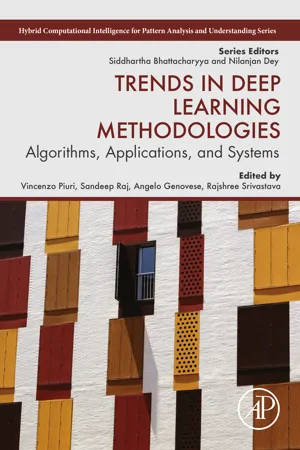
Trends in Deep Learning Methodologies
Algorithms, Applications, and Systems
- 306 pages
- English
- ePUB (mobile friendly)
- Available on iOS & Android
Trends in Deep Learning Methodologies
Algorithms, Applications, and Systems
About This Book
Trends in Deep Learning Methodologies: Algorithms, Applications, and Systems covers deep learning approaches such as neural networks, deep belief networks, recurrent neural networks, convolutional neural networks, deep auto-encoder, and deep generative networks, which have emerged as powerful computational models. Chapters elaborate on these models which have shown significant success in dealing with massive data for a large number of applications, given their capacity to extract complex hidden features and learn efficient representation in unsupervised settings. Chapters investigate deep learning-based algorithms in a variety of application, including biomedical and health informatics, computer vision, image processing, and more.
In recent years, many powerful algorithms have been developed for matching patterns in data and making predictions about future events. The major advantage of deep learning is to process big data analytics for better analysis and self-adaptive algorithms to handle more data. Deep learning methods can deal with multiple levels of representation in which the system learns to abstract higher level representations of raw data. Earlier, it was a common requirement to have a domain expert to develop a specific model for each specific application, however, recent advancements in representation learning algorithms allow researchers across various subject domains to automatically learn the patterns and representation of the given data for the development of specific models.
- Provides insights into the theory, algorithms, implementation and the application of deep learning techniques
- Covers a wide range of applications of deep learning across smart healthcare and smart engineering
- Investigates the development of new models and how they can be exploited to find appropriate solutions
Frequently asked questions
Information
Table of contents
- Cover image
- Title page
- Table of Contents
- Copyright
- Contributors
- Preface
- Chapter 1. An introduction to deep learning applications in biometric recognition
- Chapter 2. Deep learning in big data and data mining
- Chapter 3. An overview of deep learning in big data, image, and signal processing in the modern digital age
- Chapter 4. Predicting retweet class using deep learning
- Chapter 5. Role of the Internet of Things and deep learning for the growth of healthcare technology
- Chapter 6. Deep learning methodology proposal for the classification of erythrocytes and leukocytes
- Chapter 7. Dementia detection using the deep convolution neural network method
- Chapter 8. Deep similarity learning for disease prediction
- Chapter 9. Changing the outlook of security and privacy with approaches to deep learning
- Chapter 10. E-CART: An improved data stream mining approach
- Chapter 11. Deep learning-based detection and classification of adenocarcinoma cell nuclei
- Chapter 12. Segmentation and classification of hand symbol images using classifiers
- Index